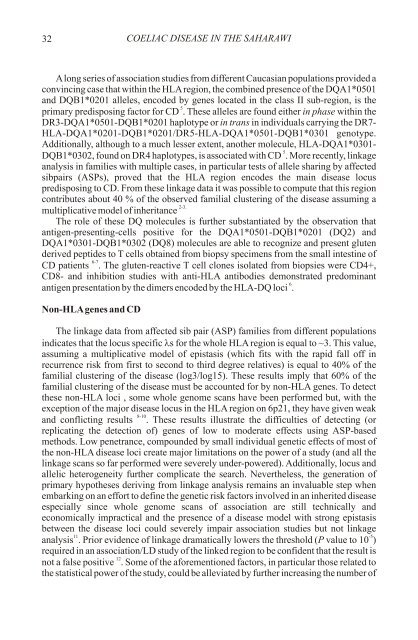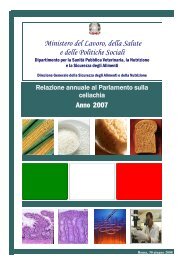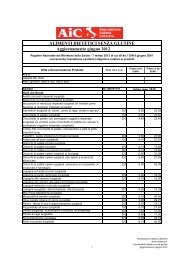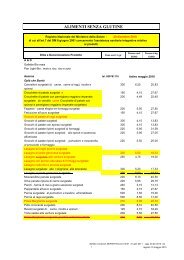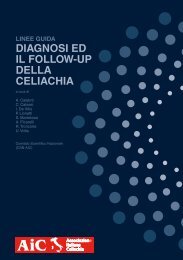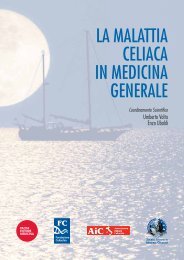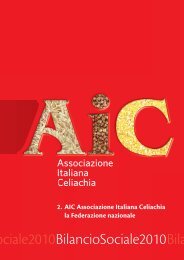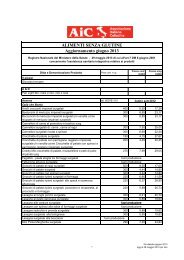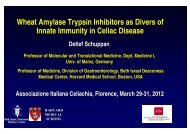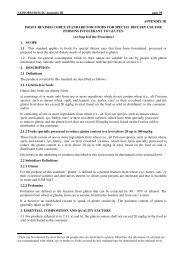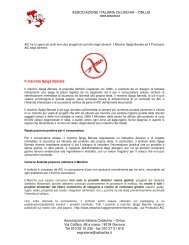primary prevention of coeliac disease - Associazione Italiana ...
primary prevention of coeliac disease - Associazione Italiana ...
primary prevention of coeliac disease - Associazione Italiana ...
Create successful ePaper yourself
Turn your PDF publications into a flip-book with our unique Google optimized e-Paper software.
32 COELIAC DISEASE IN THE SAHARAWI<br />
A long series <strong>of</strong> association studies from different Caucasian populations provided a<br />
convincing case that within the HLA region, the combined presence <strong>of</strong> the DQA1*0501<br />
and DQB1*0201 alleles, encoded by genes located in the class II sub-region, is the<br />
5<br />
<strong>primary</strong> predisposing factor for CD . These alleles are found either in phase within the<br />
DR3-DQA1*0501-DQB1*0201 haplotype or in trans in individuals carrying the DR7-<br />
HLA-DQA1*0201-DQB1*0201/DR5-HLA-DQA1*0501-DQB1*0301 genotype.<br />
Additionally, although to a much lesser extent, another molecule, HLA-DQA1*0301-<br />
5<br />
DQB1*0302, found on DR4 haplotypes, is associated with CD . More recently, linkage<br />
analysis in families with multiple cases, in particular tests <strong>of</strong> allele sharing by affected<br />
sibpairs (ASPs), proved that the HLA region encodes the main <strong>disease</strong> locus<br />
predisposing to CD. From these linkage data it was possible to compute that this region<br />
contributes about 40 % <strong>of</strong> the observed familial clustering <strong>of</strong> the <strong>disease</strong> assuming a<br />
2-3.<br />
multiplicative model <strong>of</strong> inheritance<br />
The role <strong>of</strong> these DQ molecules is further substantiated by the observation that<br />
antigen-presenting-cells positive for the DQA1*0501-DQB1*0201 (DQ2) and<br />
DQA1*0301-DQB1*0302 (DQ8) molecules are able to recognize and present gluten<br />
derived peptides to T cells obtained from biopsy specimens from the small intestine <strong>of</strong><br />
6-7<br />
CD patients . The gluten-reactive T cell clones isolated from biopsies were CD4+,<br />
CD8- and inhibition studies with anti-HLA antibodies demonstrated predominant<br />
6<br />
antigen presentation by the dimers encoded by the HLA-DQ loci .<br />
Non-HLA genes and CD<br />
The linkage data from affected sib pair (ASP) families from different populations<br />
indicates that the locus specific ls for the whole HLA region is equal to ~3. This value,<br />
assuming a multiplicative model <strong>of</strong> epistasis (which fits with the rapid fall <strong>of</strong>f in<br />
recurrence risk from first to second to third degree relatives) is equal to 40% <strong>of</strong> the<br />
familial clustering <strong>of</strong> the <strong>disease</strong> (log3/log15). These results imply that 60% <strong>of</strong> the<br />
familial clustering <strong>of</strong> the <strong>disease</strong> must be accounted for by non-HLA genes. To detect<br />
these non-HLA loci , some whole genome scans have been performed but, with the<br />
exception <strong>of</strong> the major <strong>disease</strong> locus in the HLA region on 6p21, they have given weak<br />
8-10<br />
and conflicting results . These results illustrate the difficulties <strong>of</strong> detecting (or<br />
replicating the detection <strong>of</strong>) genes <strong>of</strong> low to moderate effects using ASP-based<br />
methods. Low penetrance, compounded by small individual genetic effects <strong>of</strong> most <strong>of</strong><br />
the non-HLA <strong>disease</strong> loci create major limitations on the power <strong>of</strong> a study (and all the<br />
linkage scans so far performed were severely under-powered). Additionally, locus and<br />
allelic heterogeneity further complicate the search. Nevertheless, the generation <strong>of</strong><br />
<strong>primary</strong> hypotheses deriving from linkage analysis remains an invaluable step when<br />
embarking on an effort to define the genetic risk factors involved in an inherited <strong>disease</strong><br />
especially since whole genome scans <strong>of</strong> association are still technically and<br />
economically impractical and the presence <strong>of</strong> a <strong>disease</strong> model with strong epistasis<br />
between the <strong>disease</strong> loci could severely impair association studies but not linkage<br />
11 -5<br />
analysis . Prior evidence <strong>of</strong> linkage dramatically lowers the threshold (P value to 10 )<br />
required in an association/LD study <strong>of</strong> the linked region to be confident that the result is<br />
12<br />
not a false positive . Some <strong>of</strong> the aforementioned factors, in particular those related to<br />
the statistical power <strong>of</strong> the study, could be alleviated by further increasing the number <strong>of</strong>


